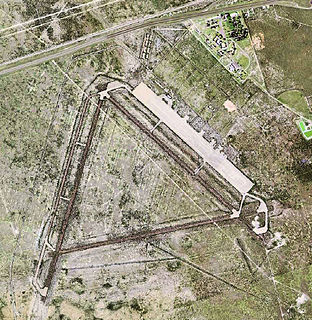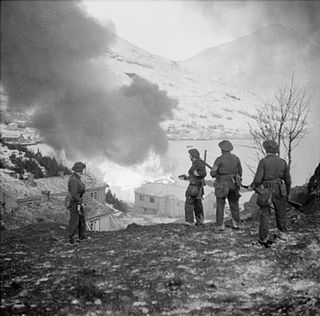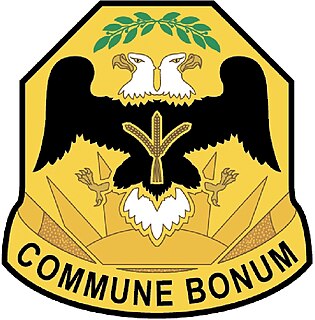Related Research Articles

Ellsworth Air Force Base (AFB) is a United States Air Force base located about 10 miles (16 km) northeast of Rapid City, South Dakota, just north of the town of Box Elder.

Kirtland Air Force Base is a United States Air Force base located in the southeast quadrant of the Albuquerque, New Mexico urban area, adjacent to the Albuquerque International Sunport. The base was named for the early Army aviator Col. Roy C. Kirtland. The military and the international airport share the same runways, making ABQ a joint civil-military airport.

Pyote Air Force Base was a World War II United States Army Air Forces training airbase. It was on 2,745 acres (1,111 ha) a mile from the town of Pyote, Texas on Interstate 20, 20 miles west of Monahans and just south of U.S. Highway 80, 230 miles (370 km) east of El Paso.

Air Force Materiel Command (AFMC) is a major command (MAJCOM) of the United States Air Force (USAF). AFMC was created on July 1, 1992, through the amalgamation of the former Air Force Logistics Command (AFLC) and the former Air Force Systems Command (AFSC).

An ammunition dump, ammunition supply point (ASP), ammunition handling area (AHA) or ammunition depot is a military storage facility for live ammunition and explosives.

Kelly Field is a Joint-Use facility located in San Antonio, Texas. It was originally named after George E. M. Kelly, the first member of the U.S. military killed in the crash of an airplane he was piloting.

The United States Army Chemical Materials Activity (CMA) is a separate reporting activity of the United States Army Materiel Command (AMC). Its role is to enhance national security by securely storing the remaining U.S. chemical warfare materiel stockpiles, while protecting the work force, the public and the environment to the maximum extent.

Norton Air Force Base (1942–1994) was a United States Air Force facility 2 miles (3.2 km) east of downtown San Bernardino, California, in San Bernardino County.

The 28th Bomb Wing is a United States Air Force unit assigned to the Eighth Air Force of the Air Force Global Strike Command (AFGSC) and is stationed at Ellsworth Air Force Base, South Dakota. The wing is also the "host unit" at Ellsworth AFB.

The Air Force Nuclear Weapons Center (AFNWC) is a USAF Named Unit, assigned to the Air Force Materiel Command at Kirtland Air Force Base, New Mexico. The AFNWC operates at the Center level of the AFMC. It is currently under the command of Major General Anthony W. Genatempo.

The 57th Wing is an operational unit of the United States Air Force Warfare Center, stationed at Nellis Air Force Base, Nevada.
The 3079th Aviation Depot Wing, Air Material Command, United States Air Force, headquartered at Wright-Patterson Air Force Base, Ohio, was a weapons of mass destruction unit of key strategic importance and special weapons storage wing active until 1962.
Crane Army Ammunition Activity (CAAA) in Crane, Indiana produces and provides conventional munitions requirements in support of United States Army and Joint Force readiness. It is one of 17 installations of the Joint Munitions Command and one of 23 organic industrial bases under the U.S. Army Materiel Command, which include arsenals, depots, activities and ammunition plants. Established in October 1977, it is located on Naval Support Activity Crane.

The Warner Robins Air Logistics Complex (WR-ALC), through about 7,000 employees at Robins Air Force Base, Georgia, provides depot maintenance, engineering support and software development to major weapon systems [F-15, C-5, C-130, C-17 and Special Operations Forces (SOF) aircraft]. The Complex achieves command objectives providing a capability/capacity to support peacetime maintenance requirements, wartime emergency demands, aircraft battle damage repair and a ready source of maintenance of critical items.

Pueblo Depot Activity(PUDA), formerly known as the Pueblo Ordnance Depot and the Pueblo Army Depot, was a U.S. Army ammunition storage and supply facility. Responsibility for the depot fell upon the U.S. Army Ordnance Corps, and the first civilians were hired in 1942 as operations began. The mission quickly expanded to include general supplies as well. It is a 24,202-acre (97.94 km2) site located 14 miles (23 km) east of Pueblo, Colorado. In 1945 they began to receive mass amounts of equipment returning from the combat theaters of World War II. Therefore, the mission expanded yet again to include the maintenance and refurbishing of artillery, fire control, and optical material. In 1951 the depot assumed responsibility to distribute U.S. Air Force ammunition for an eight-state area, as well as storage of strategic and critical materials for the General Services Administration (GSA). They were also tasked to rebuild and provide on-site maintenance support for guided missiles, ensure calibration and maintenance of electronic test equipment and radio-controlled aerial targets. They would also provide specialized training for new Army equipment as needed. In 1952, Rocky Mountain Arsenal in Denver, Colorado transferred chemical agents and chemical munitions to Pueblo Army Depot for secure storage. In 1974 Pueblo Army Depot was redesignated as Pueblo Depot Activity.
Cheli Air Force Station, formerly located within Bell in southeastern Los Angeles County, California, was a United States Air Force installation and a Cold War Radar Bomb Scoring site of the Strategic Air Command, from 1947 to 1961.

The San Antonio Air Logistics Center is a former air depot of the United States Air Force located alongside Kelly Air Force Base. It was closed as part of the 1995 Base Realignment and Closure Commission.
Sacramento Air Logistics Center is a former United States Air Force unit based at McClellan Air Force Base from 1935 until its closure as part of the 1995 Base Realignment and Closure Commission.
Mira Loma Air Force Station is a closed facility of the United States Air Force. It served as a depot for ICBM missile programs operated at Norton Air Force Base and Vandenberg Air Force Base, California. It also supported civil defense radiological equipment testing and maintenance.

Robins Air Force Base is a major United States Air Force installation located in Houston County, Georgia, United States. The base is located just east of the city of Warner Robins, 18 mi (29 km) south-southeast of Macon and approximately 100 mi (160 km) south-southeast of Atlanta, Georgia. The base is named in honor of Brig Gen Augustine Warner Robins, the Air Force's "father of logistics".
References
- ↑ "Weapon Storage Sites / Q Area".
- ↑ "Demolition of Munitions Storage Area Facilities Environmental Assessment, Ellsworth Air Force Base, South Dakota", August 2009, Section 1.2 - Background.
- ↑ "Demolition of Munitions Storage Area Facilities Environmental Assessment, Ellsworth Air Force Base, South Dakota", August 2009, Section 1.3 - Purpose and Need.
- ↑ "Demolition of Munitions Storage Area Facilities Environmental Assessment, Ellsworth Air Force Base, South Dakota", August 2009, Section 2.1 - Proposed Action, Table 2.1 - Buildings Proposed for Demolition.
- ↑ "Demolition of Munitions Storage Area Facilities Environmental Assessment, Ellsworth Air Force Base, South Dakota", August 2009, Executive Summary, page ES-1.
- ↑ "Archived copy" (PDF). Archived from the original (PDF) on 2011-09-29. Retrieved 2011-05-02.
{{cite web}}: CS1 maint: archived copy as title (link)